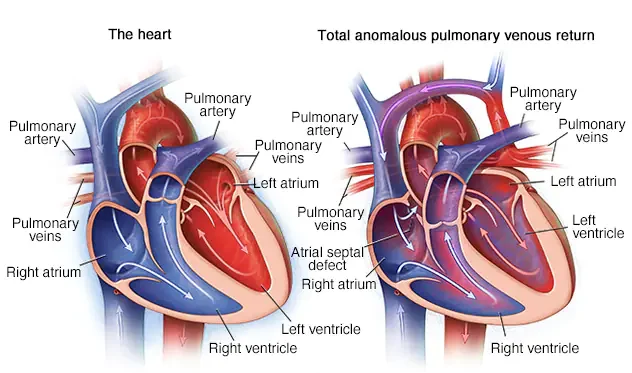What Are the Available Treatments for TAPVC?

In an anatomically normal heart, oxygenated blood from the lungs drains into the left atrium via four or more pulmonary veins. Deoxygenated blood from the systemic circulation drains into the right atrium via the superior and the inferior vena cava.
However, Partial Anomalous Pulmonary Venous Connection (PAPVC) is a spectrum of congenital heart defects. In PAPVC, one or more pulmonary veins abnormally drain into the right atrium, either directly or through draining into systemic veins.
The incidence of TAPVC ranges from 0.6 to 1.2 per 10,000 live births. Among newborns with congenital heart disease, it varies between 0.7 and 1.5 percent.
Dr. Dinesh Mittal is a renowned expert in congenital heart defects like Total Anomalous Pulmonary Vascular Connection (TAPVC). With a wealth of experience and a compassionate approach, he specializes in diagnosing and treating TAPVC, offering innovative solutions and personalized care. His dedication to excellence and patient-centric focus make him a trusted choice for families seeking treatment for TAPVC.
Recent surgical techniques and hospital care developments have improved outcomes following total anomalous pulmonary venous connection (TAPVC) repair.
This blog explores the latest treatment options for TAPVC, shedding light on the innovative approaches and improved outcomes transforming the treatment landscape of congenital heart disease.
How Does TAPVC Affect a Child?
Total Anomalous Pulmonary Venous Connection (TAPVC) affects a child by disrupting normal blood flow. In TAPVC, oxygen-rich blood from the lungs improperly drains into the right rather than the left atrium. This leads to a lack of oxygen in the body, resulting in cyanosis (blue skin color) and poor growth. The severity of symptoms depends on the type of TAPVC and the presence of other heart defects.
Dr. Dinesh Mittal explains, “TAPVC can profoundly impact a child’s health. With abnormal blood flow, oxygen-rich blood fails to reach vital organs, leading to cyanosis and poor growth. The child may appear blue and experience difficulty breathing. Prompt diagnosis and treatment are crucial to redirect blood flow and restore oxygenation.”
“Our goal is to ensure each child receives personalized care to improve their quality of life and long-term health outcomes,” added Dr Dinesh.
What Are the Treatment Options for TAPVC?
The treatment approach for TAPVC depends on several factors, including the type of TAPVC, the presence of associated heart defects, the age and overall health of the patient, and the presence of symptoms. Here are the main treatment options for TAPVC:
- Surgery: Surgical repair is the primary treatment for TAPVC. Surgery aims to redirect the pulmonary veins to the left atrium, allowing for proper oxygenated blood flow. The specific surgical technique used depends on the anatomy of the TAPVC. In some cases, a single surgery may be sufficient; in others, multiple surgeries may be required.
- Catheter Procedures: In some cases, minimally invasive catheter-based procedures may be used to treat TAPVC. This approach involves inserting a thin, flexible tube (catheter) into a blood vessel and guiding it to the heart. Once in place, the catheter is used to open up or close off abnormal blood vessels, improving blood flow.
- Medication: While medication cannot cure TAPVC, it may be used to manage symptoms and improve heart function. Diuretics, for example, may be prescribed to reduce fluid buildup in the body, while medications to support heart function may also be used.
Dr. Dinesh Mittal suggests, “The best treatment option for TAPVC depends on several factors, including the child’s age, overall health, and the specific anatomy of the defect. In many cases, surgical repair is preferred to redirect the pulmonary veins to the left atrium. However, catheter-based procedures may be suitable for certain patients. The decision is made after a thorough evaluation to determine the most effective and safest treatment plan for each child.”
Rajesh Kumar, father of a child with TAPVC, expressed his gratitude towards Dr. Dinesh Mittal for his expertise and care in treating their child. He said, “We are grateful to Dr. Dinesh Mittal for his expertise and care in treating our child’s TAPVC. His dedication and personalized approach gave us confidence throughout the treatment journey. Our child is thriving, and we cannot thank Dr. Mittal enough for his compassionate care.”
Sneha Verma, a TAPVC patient, shared her experience of the exceptional care Dr. Dinesh Mittal and his team provided during her TAPVC surgery. She mentioned, “Dr. Dinesh Mittal and his team provided exceptional care during my TAPVC surgery. Their expertise and support made me feel comfortable and confident throughout the process. I am grateful for their dedication and positive impact on my health and well-being.”
How Much Does Treating TAPVC Cost in India?
On average, the cost of surgical repair for TAPVC in India ranges from INR 3,00,000 to INR 6,00,000 (approximately USD 4,000 to USD 8,000). However, these are approximate figures, and the actual cost can vary based on the following factors:
- Hospital Type: Treatment at government hospitals is generally cheaper than private hospitals
- City: Costs vary between cities, with metropolitan areas usually having higher costs
- Treatment Approach: Surgical repair and catheter procedures have different costs
- Hospital Reputation: Well-known hospitals may have higher costs due to better facilities and expertise
- Doctor’s Fee: Experienced doctors may charge higher fees
- Additional Tests: Costs may increase if additional tests are required
- Post-Operative Care: Follow-up care and medications add to the total cost
Therefore, consulting healthcare providers for an accurate estimate based on individual circumstances is advisable.
Conclusion
Total Anomalous Pulmonary Venous Connection (TAPVC) is a congenital heart defect requiring timely and appropriate treatment. While the condition is rare, early detection and intervention are crucial for improving outcomes. Treatment options for TAPVC include surgical repair, catheter-based procedures, and medication.
Close monitoring and follow-up care are essential for ensuring an individual’s long-term health and well-being with TAPVC. With advances in medical technology and surgical techniques, the outlook for patients with TAPVC continues to improve, offering hope for a brighter future.
FAQs
1. Is TAPVC a common heart condition?
No, TAPVC is a rare congenital heart defect.
2. Can TAPVC be diagnosed before birth?
Yes, TAPVC can be detected during fetal ultrasound.
3. What are the symptoms of TAPVC in infants?
Symptoms can include cyanosis (blue skin), poor feeding, and breathing difficulties.
4. Is TAPVC a life-threatening condition?
Untreated TAPVC can lead to heart failure and other complications, making early intervention crucial.
5. Can TAPVC be cured with medication alone?
No, surgical repair is typically required to correct TAPVC and restore normal blood flow.
Explore Related Blogs What Causes Blue Baby Syndrome?
